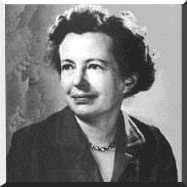 Maria
Geopper-Mayer was not only the second woman in the
Nobel's history to win the prize in the field of physics but also was
the first American woman to be honored. Maria was born on June
28,1906 in Kattowitz, a German city that is Polish now. She was
greatly influenced by her father, Dr. Friedrich Geoppert. It was
because of him that Maria developed a love for science. In the
beginning of her university-hood, she decided to study mathematics.
The year 1924, Maria Geoppert switched her study from mathematics to
physics after she attended Max Born's physics seminar and she decided
to do it in atomic physics under Max Born. Maria became a citizen of
the United States and the mother of Marianne Mayer in 1933.
Maria
Geopper-Mayer was not only the second woman in the
Nobel's history to win the prize in the field of physics but also was
the first American woman to be honored. Maria was born on June
28,1906 in Kattowitz, a German city that is Polish now. She was
greatly influenced by her father, Dr. Friedrich Geoppert. It was
because of him that Maria developed a love for science. In the
beginning of her university-hood, she decided to study mathematics.
The year 1924, Maria Geoppert switched her study from mathematics to
physics after she attended Max Born's physics seminar and she decided
to do it in atomic physics under Max Born. Maria became a citizen of
the United States and the mother of Marianne Mayer in 1933.
During the World War II, she worked for the government and helped to develop the atomic bombs that ended the war, but she wished they hadn't worked. She completed her doctoral work on an aspect of atomic structure called quantum mechanics. The theory of quantum mechanics involves very complicated mathematics and is useful to physicists in describing the motions of electrons in the atom. Our present concept of the structure of the atom is based on this theory.
She worked with Dr. Hans D. Jensen and Eugene P. Wigner, on the shell theory which was published in 1955, Elementary Theory of Nuclear Shell Structure. Mayer's shell theory explained the arrangement of particles in the nucleus atoms. In 1963, they had won the Nobel Prize, the world's most respected science prize, in physics! Besides as a Nobel winner, Maria was a member of the national Academy of sciences, the Acdemy of Heidelberg, the American Acdemy of Arts and Sciences, and a fellow of the American Physical Society.
Maria Mayer died of heart disease on Feb. 20, 1992, at the age of 65.
References
Dash, J. (1991). The Triumph of Discovery: Woman Scientists Who Won the Nobel Prize. (p.1-p.33) Englewood Cliffs, NJ: Julian Messner.
Yount, L. (1994). Contemporary Women Scientists. (p.13-p.25). New York: Facts on File.
Haber, L. (1979). Women Pioneers of Science. (p.83-p.96). New York: Harcourt Brace Jovanovich.
This Page is Created by Michel Huang.